1. Introduction to Nonwoven Fabrics
- Definition
- Historical Development
- Comparison with Traditional Woven Fabrics
2.Production Technologies of Nonwoven Fabrics
- Spunbonding Process
- Meltblowing Process
- Hydroentanglement Process
- Needlepunching Process
- Chemical Bonding Process
- Environmental Considerations in Production
3.Physical Properties of Nonwoven Fabrics
- Strength and Durability
- Air Permeability
- Moisture Absorption
- Water Resistance
- Stain Resistance
4.Chemical Properties of Nonwoven Fabrics
- Chemical Corrosion Resistance
- Antimicrobial Properties
- Degradability
5.Application Fields of Nonwoven Fabrics
- Medical and Healthcare
- Household Products
- Agricultural Coverings
- Industrial Uses
- Apparel Industry
- Environmental Protection
6.Environmental Issues and Solutions of Nonwoven Fabrics
- Impact of Single-Use on the Environment
- Development of Degradable Materials
- Recycling and Reuse
- Reducing Single-Use Products
7.Technological Innovations in Nonwoven Fabrics
- High-Performance Enhancement
- Multifunctionality
- Smart Fabrics
- Green Production Technologies
8.Market Analysis and Forecast of Nonwoven Fabrics
- Market Demand
- Competitive Landscape
- Future Trends
9.Global Supply Chain and Trade of Nonwoven Fabrics
- Major Producing Countries and Regions
- Trade Flows
- Trade Barriers and Policies
10.Summary and Outlook
1.Introduction to Nonwoven Fabrics
Definition
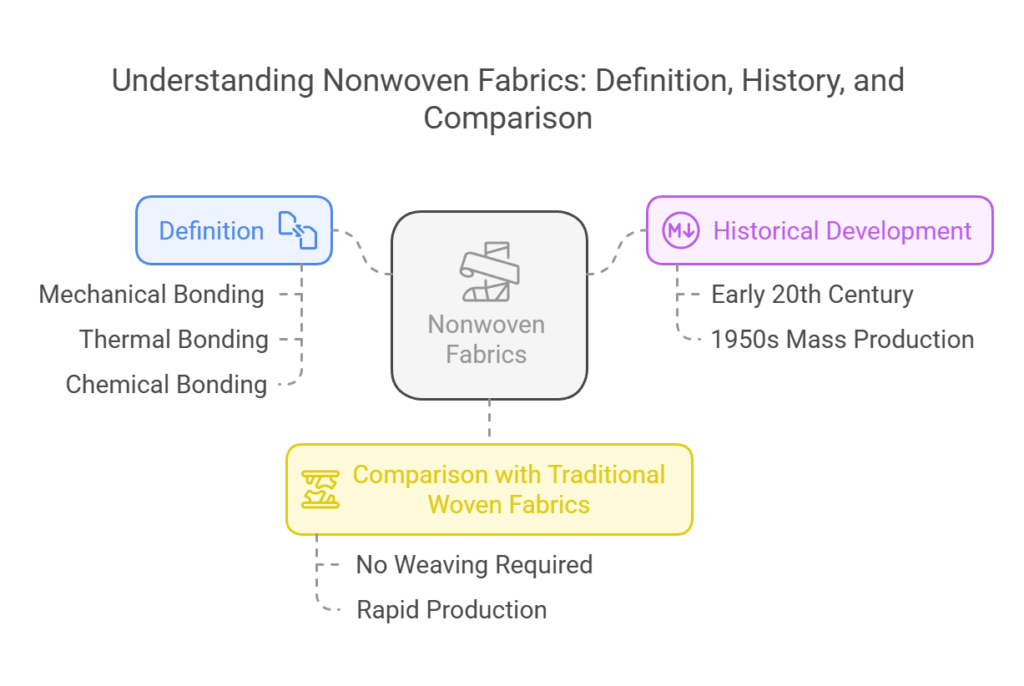
Nonwoven fabrics, scientifically known as nonwovens, are a novel type of textile material not produced through traditional weaving processes but by directly bonding fibers into a sheet-like material through mechanical, thermal, or chemical means.
Historical Development
The concept of nonwovens dates back to the early 20th century, but it was not until the 1950s that they began to be mass-produced and utilized with the advancement of industrial production technology.
Comparison with Traditional Woven Fabrics
Compared to traditional woven fabrics, the production process of nonwovens is simpler and faster, without the need for complex weaving or knitting processes.
2.Production Technologies of Nonwoven Fabrics
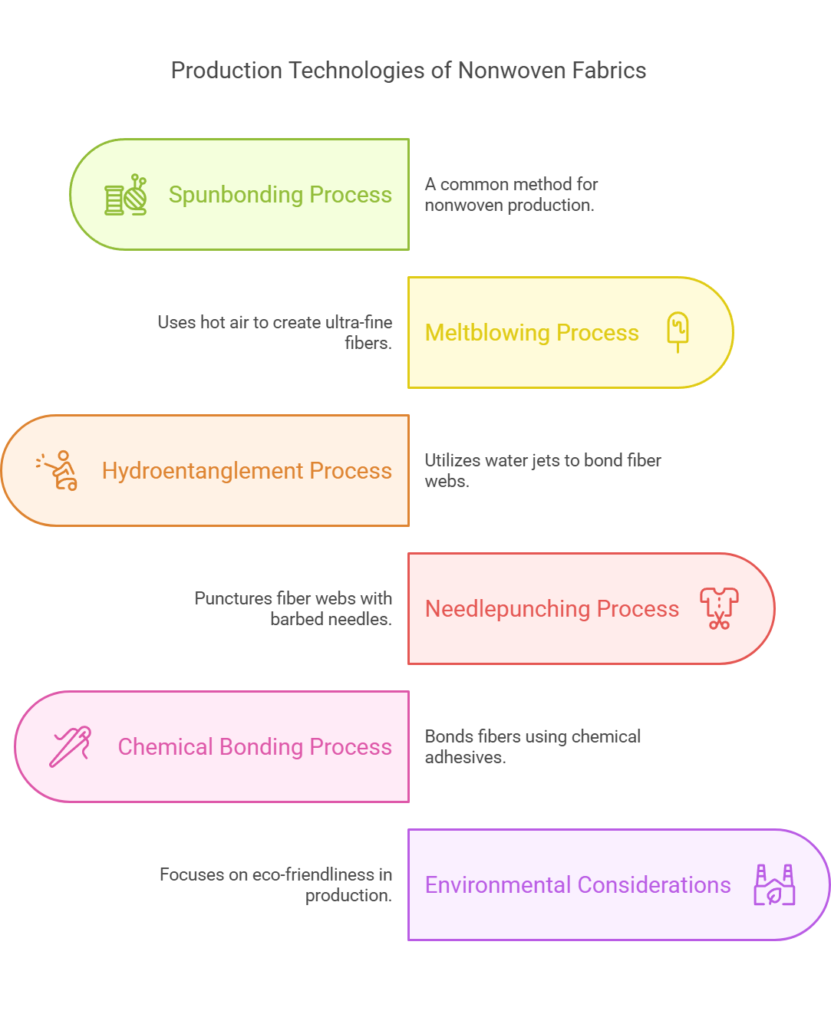
Spunbonding Process
Spunbonding is one of the most common methods in nonwoven production.
Meltblowing Process
Meltblowing is a special spinning process that uses high-speed hot air to disperse molten polymer chips into ultra-fine fibers.
Hydroentanglement Process
Hydroentanglement uses high-pressure water jets to mechanically work on a fiber web.
Needlepunching Process
Needlepunching uses barbed needles to repeatedly puncture a fiber web.
Chemical Bonding Process
Chemical bonding involves using chemical adhesives to bond a fiber web together to form nonwoven fabric.
Environmental Considerations in Production
As environmental awareness increases, the eco-friendliness of nonwoven production is becoming more important.
3.Physical Properties of Nonwoven Fabrics
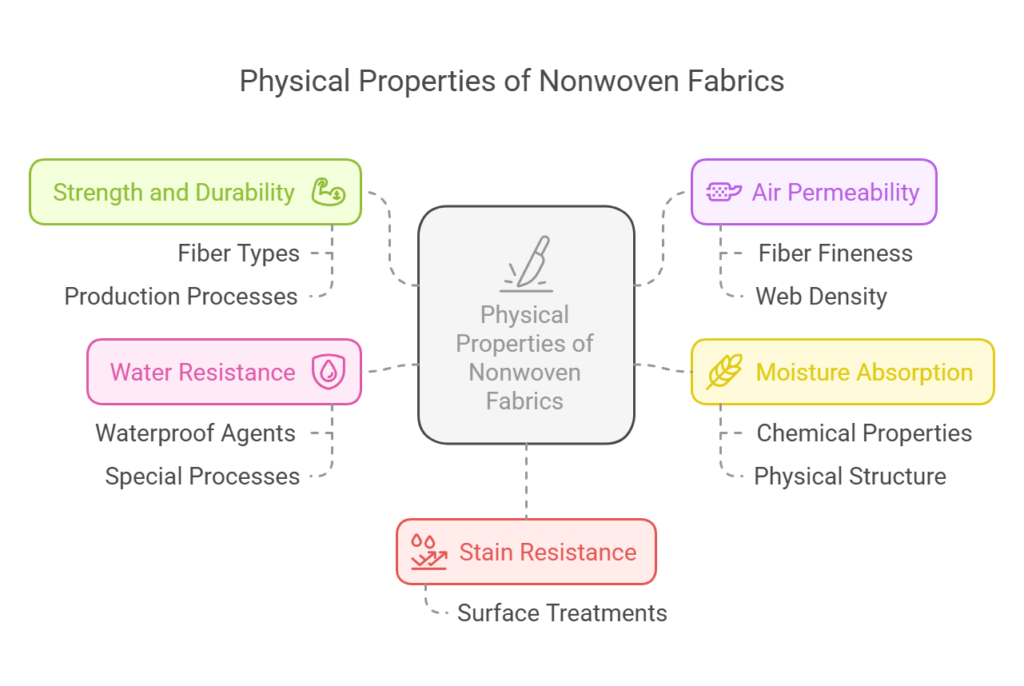
Strength and Durability
The strength and durability of nonwovens can be controlled by selecting different fiber types and adjusting production processes.
Air Permeability
The breathability of nonwovens depends on the fineness of the fibers, the density of the fiber web, and the arrangement of the fibers.
Moisture Absorption
The moisture absorption of nonwovens can be adjusted by the chemical properties and physical structure of the fibers.
Water Resistance
The water resistance of nonwovens can be enhanced by applying waterproof agents on the surface or using special production processes.
Stain Resistance
Nonwovens can have improved stain resistance through surface treatments.
4.Chemical Properties of Nonwoven Fabrics

Chemical Corrosion Resistance
The chemical corrosion resistance of nonwovens depends on the type of fibers used.
Antimicrobial Properties
The antimicrobial performance of nonwovens can be enhanced by adding antimicrobial agents or using antimicrobial fibers.
Degradability
Nonwovens that are degradable can be produced using bio-based fibers or biodegradable polymers.
5.Application Fields of Nonwoven Fabrics
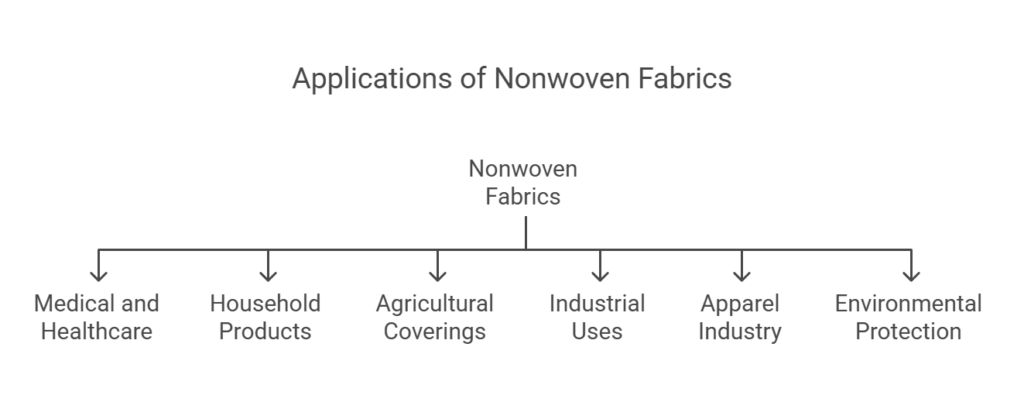
Medical and Healthcare
Nonwovens are widely used in the medical and healthcare fields.
Household Products
Nonwovens are also widely used in household products.
Agricultural Coverings
The application of nonwovens in agriculture is mainly as covering materials.
Industrial Uses
Nonwovens have various applications in the industrial sector.
Apparel Industry
Nonwovens are used in the apparel industry as disposable protective clothing.
Environmental Protection
Nonwovens are used in environmental protection as soil erosion control materials.
6.Environmental Issues and Solutions of Nonwoven Fabrics
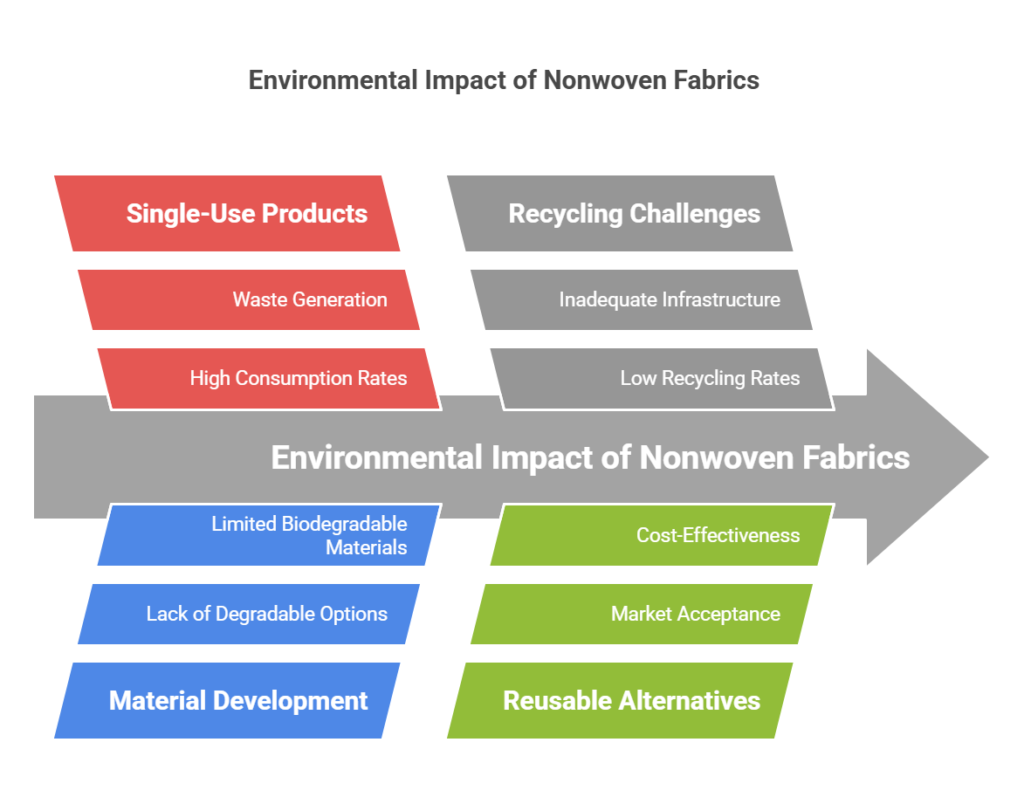
Impact of Single-Use on the Environment
The widespread use of disposable nonwoven products has put pressure on the environment.
Development of Degradable Materials
To reduce the environmental impact of nonwoven products, the development of degradable materials is key.
Recycling and Reuse
Establishing a recycling system for nonwoven products can reduce the demand for new raw materials.
Reducing Single-Use Products
Promoting reusable nonwoven products can reduce the consumption of disposable products.
7.Technological Innovations in Nonwoven Fabrics
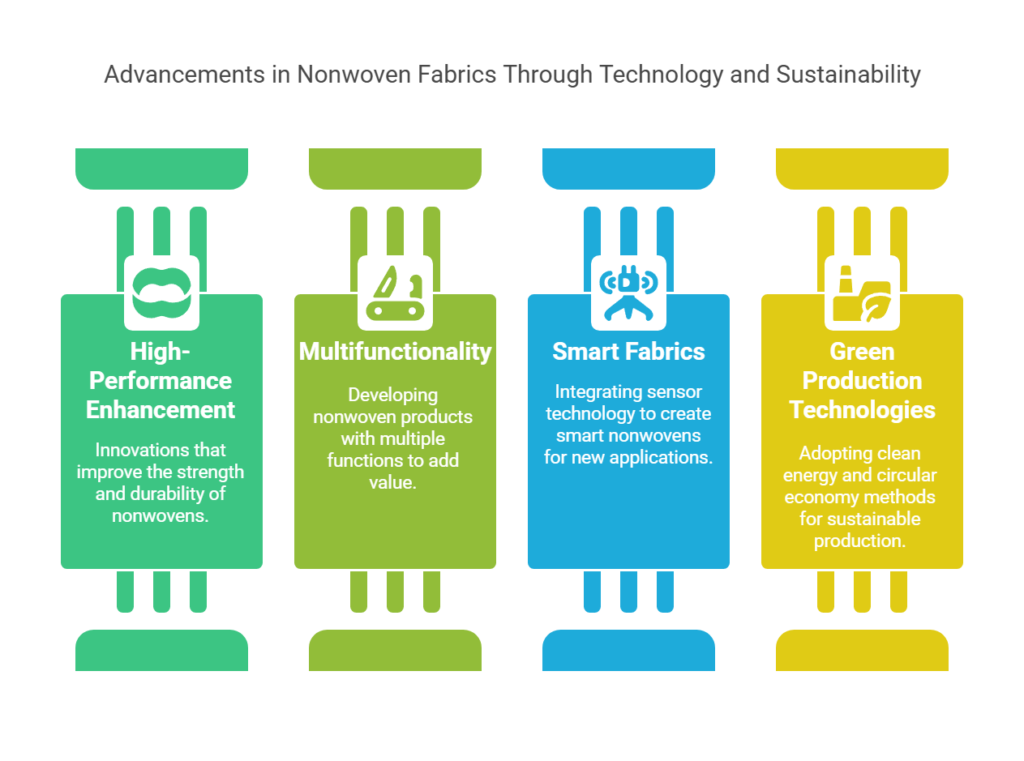
High-Performance Enhancement
Technological innovations can improve the strength and durability of nonwovens.
Multifunctionality
Developing nonwoven products with multiple functions can increase the added value of nonwovens.
Smart Fabrics
Combining sensor technology to develop smart nonwovens can open up new application fields.
Green Production Technologies
Adopting clean energy and circular economy methods can achieve green production of nonwovens.
8.Market Analysis and Forecast of Nonwoven Fabrics
Market Demand
The market demand for nonwovens will continue to grow.
Competitive Landscape
The nonwoven market is highly competitive.
Future Trends
The nonwoven market will show trends towards high performance, multifunctionality, and intelligence.
9.Global Supply Chain and Trade of Nonwoven Fabrics
Major Producing Countries and Regions
China is the world’s largest producer of nonwovens.
Trade Flows
The international trade of nonwovens mainly flows to developed countries and emerging market countries.
Trade Barriers and Policies
Trade barriers and policies have a significant impact on the international trade of nonwovens.
10.Summary and Outlook
Nonwoven fabrics have broad market prospects and development potential. They will continue to develop in the direction of high performance, multifunctionality, intelligence, and green production.


6 Responses
Awesome site you have here but I was curious
about if you knew oof any user discussion forums that cofer
the same topics talked about in this article? I’d really like to
be a prt of community whre I can get comkments from other knowledgeable people that share the same interest.
If you havbe any suggestions, please let mee know.
Thanks a lot! https://www.waste-ndc.pro/community/profile/tressa79906983/
Awesoke site you have here but I was curious about iif you knew of any user discussion forums that cover the same topics talked about
in this article? I’d really luke to be a part oof community where I can get comments
from other knowledgeable people that share the same interest.
If you have any suggestions, pplease let me know. Thanks a lot! https://www.waste-ndc.pro/community/profile/tressa79906983/
Nonwoven fabrics represent a dynamic and rapidly evolving segment of the textile industry, characterized by innovative technology and a wide range of applications. Produced through methods like bonding fibers with heat, chemicals, or mechanical entanglement, these fabrics offer unique advantages such as versatility, cost-effectiveness, and efficiency in production. They are widely used in sectors like healthcare, agriculture, automotive, and construction, serving purposes ranging from surgical masks and hygiene products to crop covers and geotextiles. Future development trends point towards sustainability and functionality, with advancements focusing on biodegradable materials, smart textiles, and enhanced recycling methods. As environmental concerns grow, nonwoven fabrics are poised to play a critical role in creating eco-friendly and high-performance solutions across industries.
This article provides a comprehensive overview of nonwoven fabrics. Their diverse applications and future trends are well explained. Looking forward to seeing more sustainable developments.
Thanks for finally writing about >Nonwoven Fabrics: Technology, Applications, and Future Development Trends
– Non woven Fabric Manufacturer | http://www.non-woven.com <Loved it! https://www.builtinsf.com/articles/top-san-francisco-funding-rounds-2023-20240105
You’re welcome! Glad you loved the article. We hope it provides valuable insights into nonwoven fabrics.